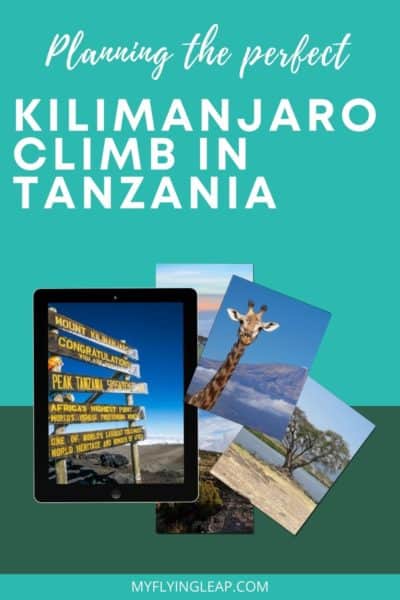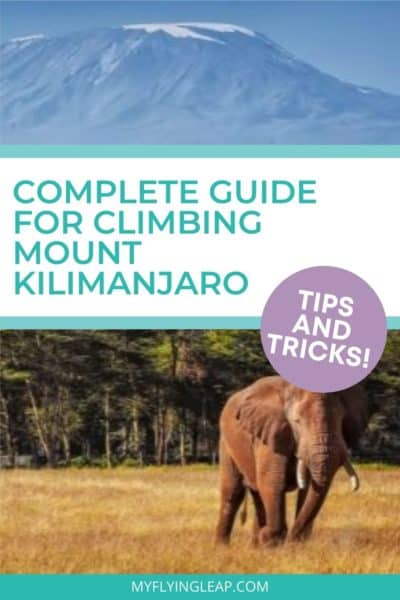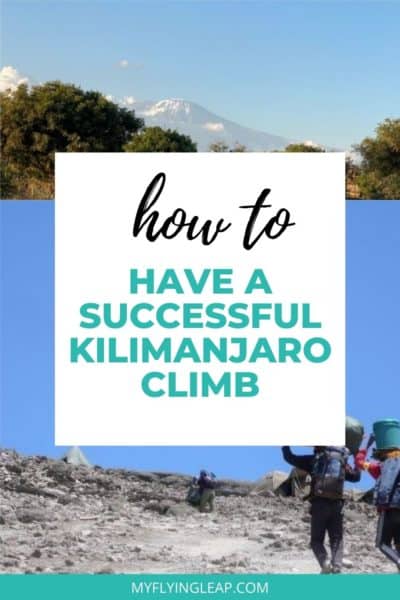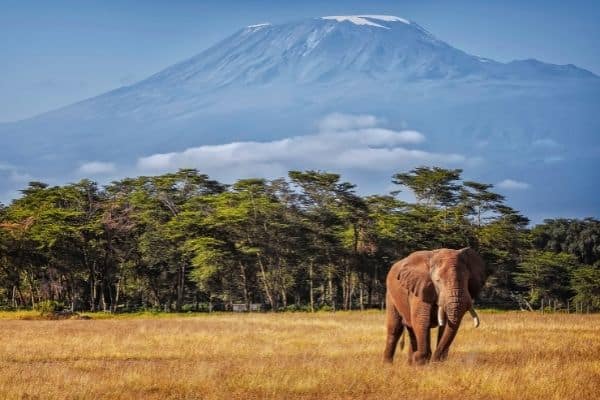How to Climb Mount Kilimanjaro— Ultimate Guide + Tips
So, you’ve decided to climb Mount Kilimanjaro. Your friends and family might say you’re crazy, it’s true.
However, most climbers find that the Kilimanjaro hike is one of the best decisions they’ve ever made. It will push you physically and mentally and give you a great sense of accomplishment once you reach the peak.
I climbed Mount Kilimanjaro in 2020 and it’s still one of the best things I’ve ever decided to do. As the tallest free-standing mountain in the world and the tallest mountain in Africa, Mount Kilimanjaro draws in thousands of hikers and climbers every year.
It’s located in Tanzania, giving you ample opportunities to explore national parks and Swahili culture both before and after your hike.
I put together this complete guide to help you through the process of planning the hike and to share my best preparation tips. Having the right gear and tour company are key to making your hike successful, so I’ve included tips on those as well!
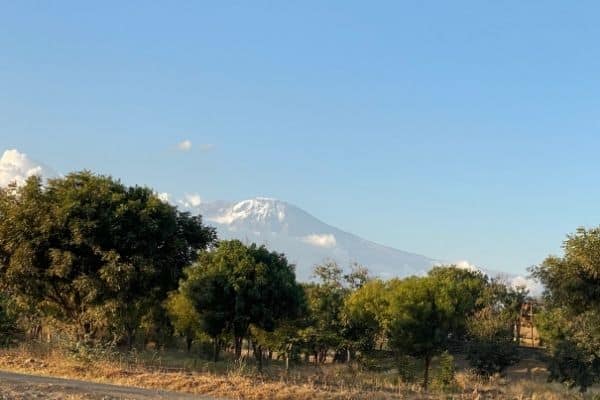
This post may contain affiliate links, which means I’ll receive a commission if you purchase through my links, at no extra cost to you. Please read full disclosure for more information.
Choosing the Right Tour Company to Climb Mount Kilimanjaro
Before diving into tour companies, it’s important to note that you cannot climb the mountain without a tour guide. The Tanzanian government made it illegal in 1991. To get into the national park, you must be with a licensed tour company.
You also can’t climb without a porter. Each climber is required to have their own porter that carries all their gear and cooking equipment. Your tour company will assign you a porter that will pack your bag and carry your gear every day.
Your porter will also climb slightly ahead of you at the end of every day and set up your tent and cook dinner. So, when you reach the campsite at the end of the day, your sleeping arrangements and food will be ready. The porter makes it extremely easy for you to just concentrate on climbing. Trust me; you’ll need it.
I highly recommend the tour company I used, Meijo Safaris. They take groups of any size, including solo climbers. (Prices are always higher if you’re alone or have fewer people.) They also do safaris, so I booked my climb and safaris in a package, which saved me a ton of money.
The owner, Daudi, is amazing. They have all kinds of gear for rent, and they make sure to take the best possible care of you when climbing.
Their drivers are also never late, so you will always be picked up at the airport or your hotel on time. This is a rarity in Tanzania, as most companies follow “African time.” In East Africa, you’ll find it common for people, even professionals, to be an hour late or more.
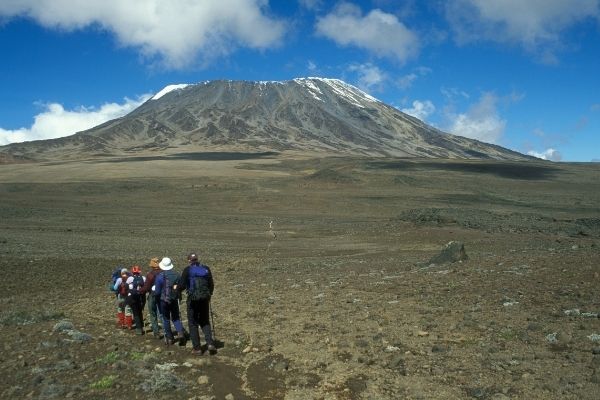
Must-Ask Questions Before Booking
My only first-hand experience with a tour company is with Meijo Safaris. But, I can offer some tips when trying to choose a tour company along with some questions you should ask the tour operator before going.
I would also recommend that you book through the tour operator and not go through a travel agent. It will be much cheaper.
- What kind of food is cooked on the mountain? Do you offer meals for people with dietary restrictions (if required)?
- Do you offer transportation to and from the airport? (The answer should be yes, and it should be included in your price).
- Do you offer recommendations or discounts at nearby hotels? (Many companies do).
- Do you offer the option to rent gear if I don’t bring my own? What brands do you have available for rent?
- Ask for proof of legal requirements to bring you up the mountain. This includes public liability insurance and a Tanzanian Tourist Board license.
- What is the guide-to-client ratio?
- Many climbing companies do not treat their guides and porters ethically. Ask for proof of membership to the Tanzania Porters Organization (TPO) and the Kilimanjaro Guides Association (KGA).
- What are their rules and guidelines for flight delays and lost luggage? A delay will affect your climbing date.
- Do they offer an orientation to go over guidelines about safety? What happens if someone gets hurt on top of the mountain?
- Do they bring oxygen in case you need it?
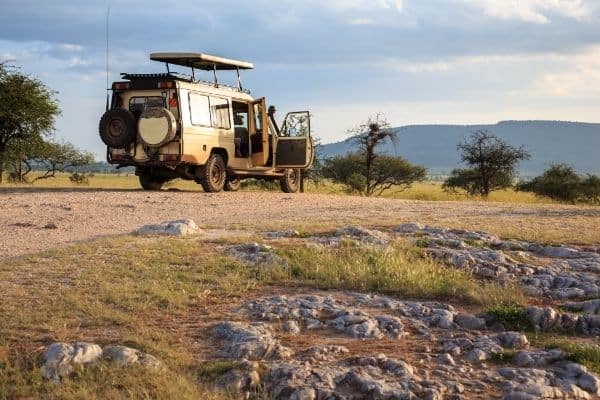
How Can I Find a Tour Company?
Unfortunately, the easiest way to find a tour company is not the most practical. I found out about Meijo Safaris because I was already in Tanzania and asked my hostel owner who he would recommend taking me up the mountain.
Finding tour companies this way is often the easiest and best way because locals will be able to give you a recommendation based on first-hand knowledge. You can also ask when you book your hostel or hotel for their recommendation.
If you are already in Tanzania or East Africa on a backpacking trip, I recommend asking your hostel or hotel owners to see if they can advise you. They might also be able to give you better deals if they know the owner of the tour company.
If you want to plan ahead before you book your accommodations and are only coming to Tanzania for Kilimanjaro, I recommend going through Facebook and Trip Advisor to find the best companies with the best reviews.
Always check the company’s website and Facebook page to make sure they are reputable and safe. Reach out to the company owner to seek advice and ask them the questions listed above.
Mount Kilimanjaro Routes—How to Choose the Right One For You
The route you choose is probably the second most important decision you’ll make, after choosing the tour company. There are seven main routes up and down the mountain. Most tour companies will only offer you the option to use the three below:
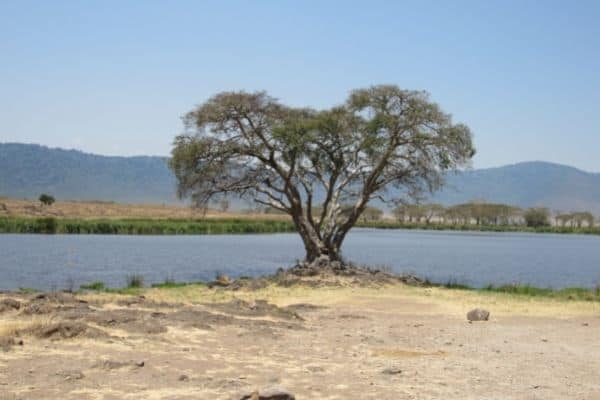
Marangu Route
This is one of the most popular routes today. It was one of the first established routes used by ancient people to get up the mountain.
Although it’s considered the easiest path up the mountain, you will still need a minimum of 5 days to get up and one day to get down. Most people need an extra day to get up, though, unless you’re a superstar climber.
One of the major pros of this route is that you get to sleep in huts with actual beds. If you aren’t a fan of camping or tent life, this might be the route for you. It’s also a better choice if you’re climbing during the rainy season (March through May) as you don’t have to sleep on the wet ground.
Since this climb has the least incline, it’s also the least scenic. You also take the same way up that you do down, so no extra views when you’re coming out of the mountain.
Interested in the Marangu route? Here’s a great tour option for the Marangu route with great ratings.
Machame Route
This is the climbing route I took! This route is considered more difficult and is recommended for those that are better in shape and did some training for the climb.
Having hiking experience is also recommended. It’s the most trafficked of all the routes, so you will probably be climbing with a large group. And you’ll probably encounter many other groups along the way.
You will need at least six days to get up the mountain and two days to get down. The scenery is stunning, giving you much better panoramic views than Marangu.
Here’s a well-rated Machame route tour of Kilimanjaro.
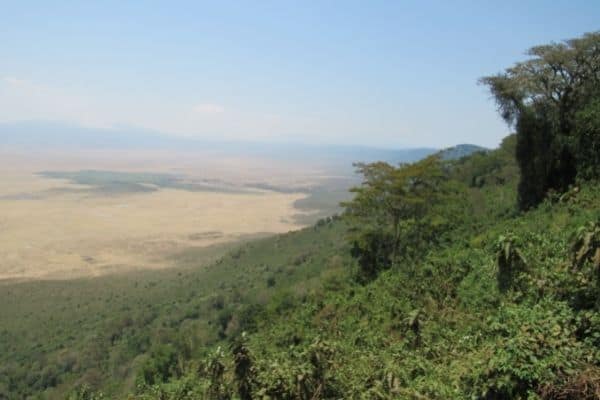
Lemosho Route
Lemosho Route starts as its own trail and then later merges with Machame. It’s the only route that starts on the west side of the mountain, so you get better views of Shira Ridge and Shira Camp.
If you are most interested in exploring many parts of the mountain and getting the best views, this is the route you should choose.
You need at least eight days to get up the mountain and two days to get down, although experienced backpackers can make it up the mountain in six days.
Here’s a great guide option for the Lemosho route.
Climbing Mount Kilimanjaro Cost and Budget
The cost of your climb will largely depend on the time of year you go and the tour company you use. I would advise you to budget at least $1,500 USD for the climb, and that’s the bare minimum. Most climbers pay somewhere between $2,000 to $4,000 USD.
Along with the climb, you need to factor in the cost of the gear you need to buy. Make sure you buy high-quality items that will last you through the hike. Most people spend around $500 on gear.
If you plan to rent gear, the cost will depend on which items you’re renting. My duffel bag rental was $30 and my tent was $70. I also rented trekking poles for $20. I didn’t rent any clothes, but I remember it being very cheap- about $10 per item. If you rent every item including clothes and gear, you might spend around $300. The exact price will depend on your guide though and if the items are new or used.
The last major thing you need to budget for is your flight. You will fly into Kilimanjaro International Airport (JRO) in Moshi, Tanzania. Depending on where your home country is, the flight will be between $800-$2,000 USD.
You will also need to pay for a tourist visa on arrival. It’s $100 for Americans and $50 for most other nationalities.
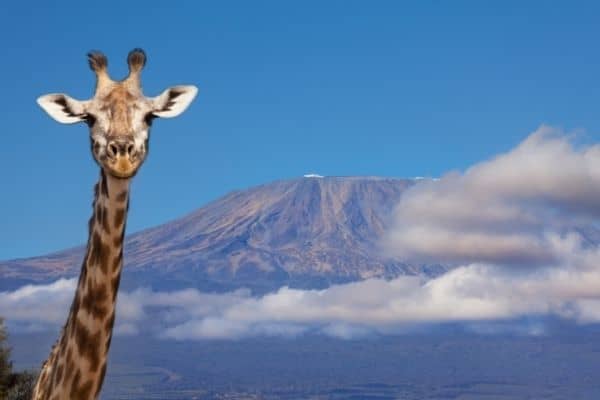
What Do I Need to Bring to Climb Mount Kilimanjaro?
It’s important to note that you can bring your own gear or you can rent it from the company.
If you don’t already have backpacking and climbing gear, I recommend you rent most of your items from the tour company. This saves you money in materials and checked bags at the airport.
Though you can rent much of your gear, there are some items you need to bring of your own. This includes your boots and clothing, as renting them can be tricky. Here is the gear you will need to hike Mount Kilimanjaro.
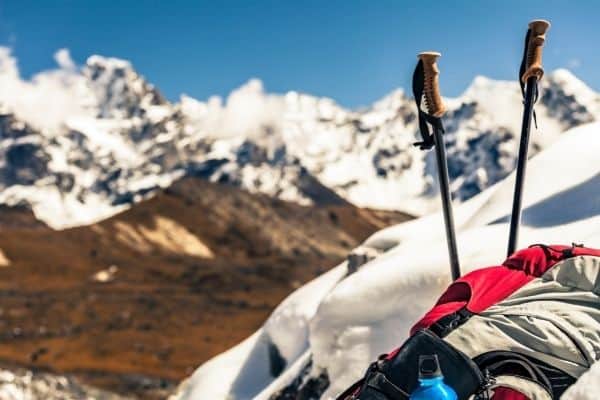
Hiking Gear
- 30L daypack. This is very important and needs to fit well as it’s what you will be carrying. I had one with a water bladder fitted inside to make it easier to hydrate.
- Headlamp.
- Sleeping bag. Mine was rated for all 4 seasons and -20 degrees. I also brought a compression sack for it.
- Waterproof duffel bag. This is what the porter will carry for you. I rented mine from the company, but they recommend 80-90L if you bring your own.
- Trekking poles. I also rented these.
- Tent. Also rented. I don’t remember the brand, but they suggest you bring a 4 season tent that’s specifically designed for rugged mountain climbing.
Clothing
Layers are important when climbing! Here is what I brought when I climbed and I had all that I needed:
- Insulated winter jacket
- Fleece jacket
- 4 dry wick short sleeve shirts
- 3 long sleeve hiking shirts
- A pair of underwear and a sports bra for every day
- 3 tank tops for layering
- 2 pairs of loose hiking pants
- 2 pairs of workout pants
- 1 pair of insulated pants
- Waterproof jacket
- Hiking boots
- Hiking shoes or warm sneakers for wearing at the campsite
- Fresh socks for everyday
- Gaiters to cover the bottom of your pants from getting wet
- Sunglasses
- Baseball hat
- Mittens or snow gloves
- Hiking scarf
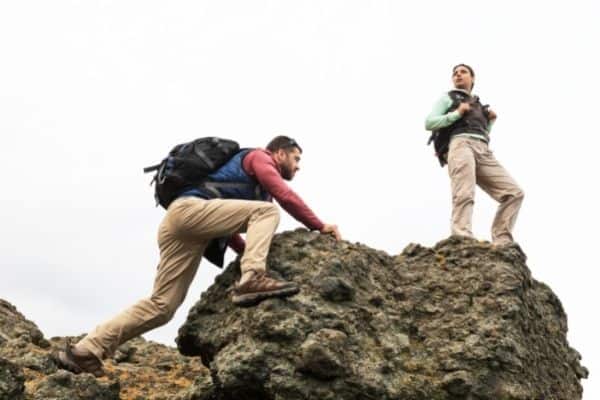
Miscellaneous
- Sunscreen
- Personal snacks like granola bars, nuts, and electrolyte drink mixes
- Wet wipes and toilet paper
- Camera and phone
- Toiletry items like shampoo, toothbrush, toothpaste, etc.
- Quick-dry towel
- Hand sanitizer
- Pocket knife
- Nail kit (your nails get extremely dirty)
You don’t need a first aid kit or any medicines unless you have a prescription medication that you need to bring with you. One of the extra porters carries a huge medical and first aid kit, so you don’t need to waste space in your bag.
Your porters and tour guides will probably show up to climb with you in jeans and sneakers. They’ve climbed the mountain hundreds if not thousands of times. I wouldn’t advise you under any circumstances to go cheap on clothing or boots. Your clothes will keep you comfortable and dry throughout the climb.
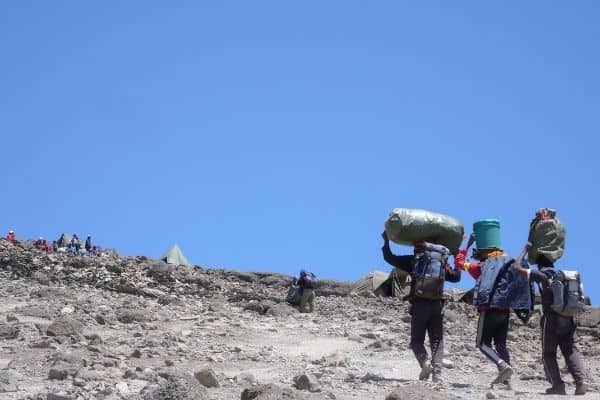
Do I Need to Train to Climb Mount Kilimanjaro?
It’s a good idea to be in the best shape you possibly can be before attempting to trek Kilimanjaro. However, you don’t need to do any heavy-duty training or mountain climbing.
At a minimum, make sure you’re hiking, walking, or running every day. You might also want to try hikes with large elevation changes to get used to changing altitude.
Exercising for extended periods of time is also key. While climbing Kilimanjaro, you will be walking for 12 to 14 hours a day. Try going for long hikes or weekend hikes that have you up and moving for long hours every day.
How Long Will I Spend on the Summit?
You don’t spend a ton of time on the summit as oxygen is limited. You will usually only stay as long as it takes you to take photos and enjoy the scenery-about 20-30 minutes or less. Keep in mind the scenery at the top is really just snow and clouds. The best views are as you climb up the mountain.
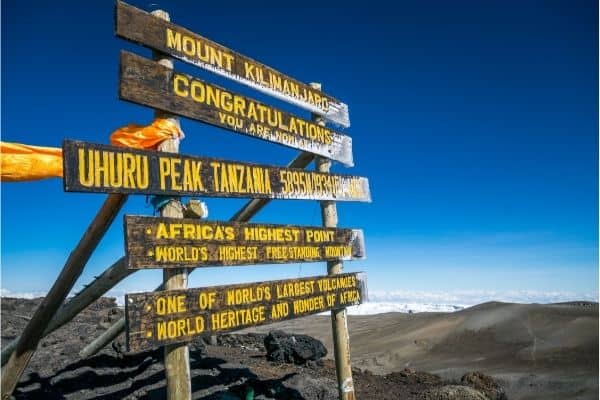
Where Will I Sleep/Shower/Go to the Bathroom?
Unless you are taking the Marangu route, you will be sleeping in tents for the duration of the climb. Your porters will give you a bucket of water to shower while on the route. They will boil some water and then add cold water on top of it, so you get a nice warm bath.
You will need to use a small cup or your water bottle to dump water over your head after you shampoo and soap up. It’s kind of similar to how you might bathe a baby or small child when you pour water on them to wash the soap off in the tub.
On cold nights, you can ask them to boil the water so you can take a warm bucket shower. Most companies also set up handwashing stations.
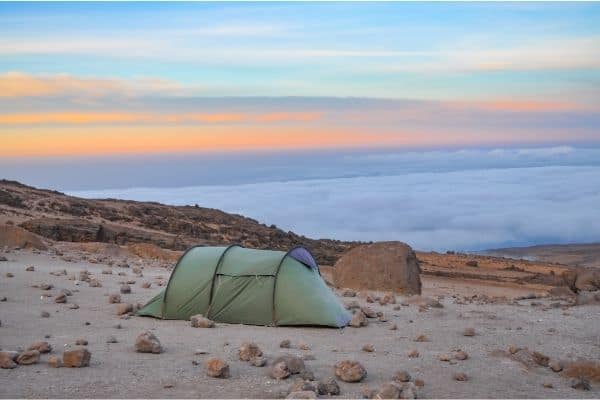
For your toilet needs, you have a few options. The designated campsites have bathrooms. By bathroom, I mean a sheltered stall with a nonflushing squatty toilet. They aren’t comfortable, but it does give you some privacy.
Some people also choose to just go into the bushes. No matter what option you choose, make sure to put your toilet paper and other bathroom trash where your porter tells you to. Don’t leave it out in the wilderness.
Surprising Facts About Climbing Kilimanjaro
Just in case I scared you with all the technical talk above, here are some facts that should ease your mind:
- Kilimanjaro is a walk-up mountain. Despite it being called “climbing Kilimanjaro,” you’re really just walking to the summit. No climbing experience or climbing gear is required. It’s steep, and your muscles will burn, but you don’t need to worry about actually climbing a mountain.
- Most people don’t need oxygen to reach the peak. You can summit without supplemental oxygen unless you have a pre-existing health condition. With that being said though, always go with a tour company that brings oxygen. You never know when you might need it.
- Most routes have a 65-70% success rate. If you’re in moderately good shape and set your mind to make it to the top, you will. Reaching the top of Kilimanjaro has more to do with your mental state than your physical shape, as most climbers will tell you.
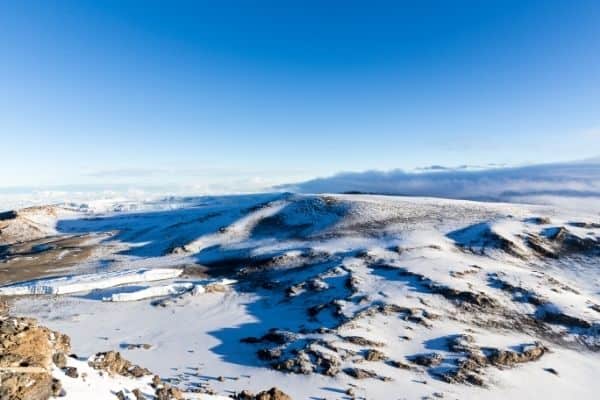
Ready to Climb Mount Kilimanjaro?
I hope after this guide and tips, you feel confident to start prepping for your climb. Finding the tour company might be the hardest part, but once that’s done, you can relax and let them do the rest of the work for you!
Climbing Kilimanjaro is an unforgettable experience and a once-in-a-lifetime opportunity. Make sure you get all your gear ready and get some training under your belt to make the experience more enjoyable and easier.
Are you preparing for the climb? What are you most nervous about? If you’ve already completed the climb, what are some tips you can offer? Comment below!
You Might Also Like
- Why You Should Visit Kilimanjaro National Park
- Top 4 National Parks of Tanzania & Why You Should Visit
- Top 7 Reasons to Visit Serengeti National Park, Tanzania
- 7 Best Things to Do in Arusha & Moshi, Tanzania
- Best Time to Visit Zanzibar & Top Zanzibar Tourist Attractions
- Best Hotels in Arusha—Top Areas & Accommodations
- Best Places to Stay in Zanzibar: Top Areas & Accommodation
- Living in Arusha, Tanzania—Digital Nomad Guide
Like it? Pin it!
